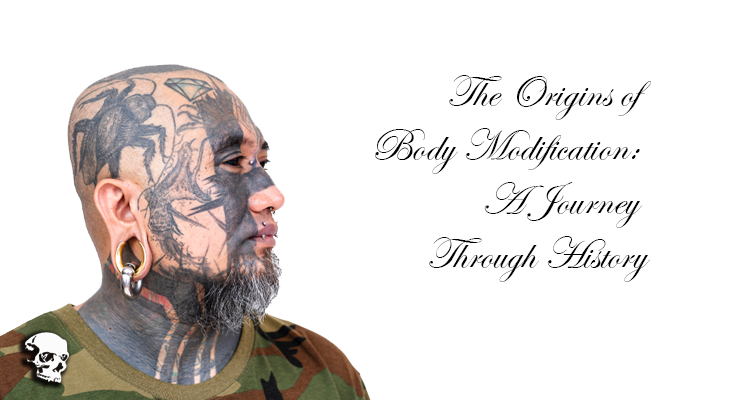Currently Empty: $0.00

The Origins of Body Modification: A Journey Through History
Ancient Practices and Symbolism
Body modification has deep roots in human history, with archaeological evidence revealing its significance over the millennia. For instance, people have practiced tattoos and piercings for over 5,000 years, as archaeological evidence reveals their presence on Ice Age remains and Egyptian mummies. These ancient forms of body modification were not merely decorative but carried profound symbolic meanings.
In the Upper Palaeolithic era, stone tools were used for head shaving, scarification, and other body modifications, underscoring the symbolic importance of these practices. These early modifications often signified rites of passage, social status, or religious beliefs. For example, Ötzi the Iceman, a well-preserved natural mummy from around 3300 BCE, had intricate tattoos that suggest people used tattoos for therapeutic purposes, as well as for cultural and spiritual reasons.
In ancient Egypt, female mummies predominantly had tattoos, showing their role in fertility rites and protective magic. The tattoos often depicted symbols of fertility and protection, such as the goddess Neith. These practices highlight the multifaceted role of body modification in ancient societies, blending the aesthetic with the spiritual and the societal.
Cultural Variations
Different cultures have embraced body modification in unique ways, reflecting both universal and culturally specific traditions. East Asia, for instance, has a rich history of body modification practices that range from tattooing and tooth blackening in prehistoric times to contemporary cosmetic surgery. In Japan, the intricate art of Irezumi tattooing has been practiced for centuries, originally as a form of punishment and later evolving into a respected art form with deep cultural significance.
Similarly, in the Tiwanaku society of the southern Andes, cranial shape modification served as a means of symbolic boundary maintenance, reflecting diverse cultural identities. This practice involved binding the skulls of infants to elongate their heads, a sign of social status and ethnic identity. Such modifications were believed to enhance intelligence and were often associated with the elite classes.
In Africa, scarification has been a prominent form of body modification, used to signify tribal affiliation, social status, and milestones in a person’s life. The Yoruba people of Nigeria, for example, practice facial scarification as a mark of beauty and identity. These cultural variations illustrate the diverse motivations and methods behind body modification practices, highlighting the interplay between individual expression and social norms.
Modern and Neo-Primitive Movements
The 20th and 21st centuries have witnessed a resurgence in body modification practices, driven by both aesthetic preferences and deeper socio-cultural movements. The Neo Primitive movement, for example, emphasizes radical body marking practices as a form of social resistance and personal expression. This movement seeks to reconnect with ancient traditions and challenges modern societal norms through body modification.
Modern societies have also seen a resurgence in the popularity of tattoos, piercings, and scarification, reflecting the evolving nature of body modification as both a cultural and personal statement. Tattoos, once stigmatized as markers of deviance, have become mainstream and are now celebrated as forms of art and personal narrative. This shift reflects broader changes in social attitudes towards body modification and individual expression.
Scarification, once practiced primarily in indigenous cultures, has also gained popularity in contemporary alternative subcultures. These modern practices often draw inspiration from traditional methods while incorporating new techniques and materials. The blending of ancient and modern practices in the Neo Primitive movement underscores the enduring appeal and adaptability of body modification.
Social and Psychological Perspectives
Many individuals see body modification practices as self-constructive actions that challenge social norms and deterministic biology, reflecting deeper psychological and social processes. For many individuals, body modifications such as tattoos and piercings serve as a means of reclaiming agency over their bodies and identities. This is particularly evident in marginalized groups, where body modification becomes a form of resistance against hegemonic social structures.
In various cultures, body modifications have been used to signify transitions, identity, and resistance. For instance, in the Pacific Northwest, the potlatch ceremony involves extensive body modifications, such as piercing and tattooing, to mark significant life events and assert social status. These practices are deeply embedded in the cultural fabric and serve as a means of maintaining social cohesion and individual identity.
From a psychological perspective, body modification can be a powerful tool for coping with trauma and asserting control over one’s body. For some, it serves as a form of self-expression and a way to externalize internal experiences. Studies have shown that individuals with a history of trauma are more likely to engage in body modification practices as a means of healing and empowerment.
The Timeless Significance of Body Modification
The history of body modification is rich and varied, encompassing a wide range of practices that reflect cultural, social, and individual identities. From ancient tattoos and cranial modifications to modern cosmetic surgeries and Neo Primitive rituals, body modification continues to be a powerful form of expression and identity. As society evolves, so too does the significance and practice of body modification, reflecting the ever-changing landscape of human culture and personal identity.
In conclusion, body modification practices have been an integral part of human history, serving as markers of cultural identity, social status, and personal expression. The diverse methods and motivations behind these practices highlight the complex interplay between individual agency and societal norms. As we continue to explore and understand these practices, we gain deeper insights into the human experience and the ways in which we shape and are shaped by our bodies.
Are you enjoying this article or our site? Love of Gothic and the Dark Matters & Mischief magazine are run by dedicated volunteers, and we rely on crowdfunding to cover our expenses. Your support is crucial to keep us going! Consider becoming a paying member of our Patreon or purchasing something from our shop to help us continue providing content and community support. Thank you for your support!
